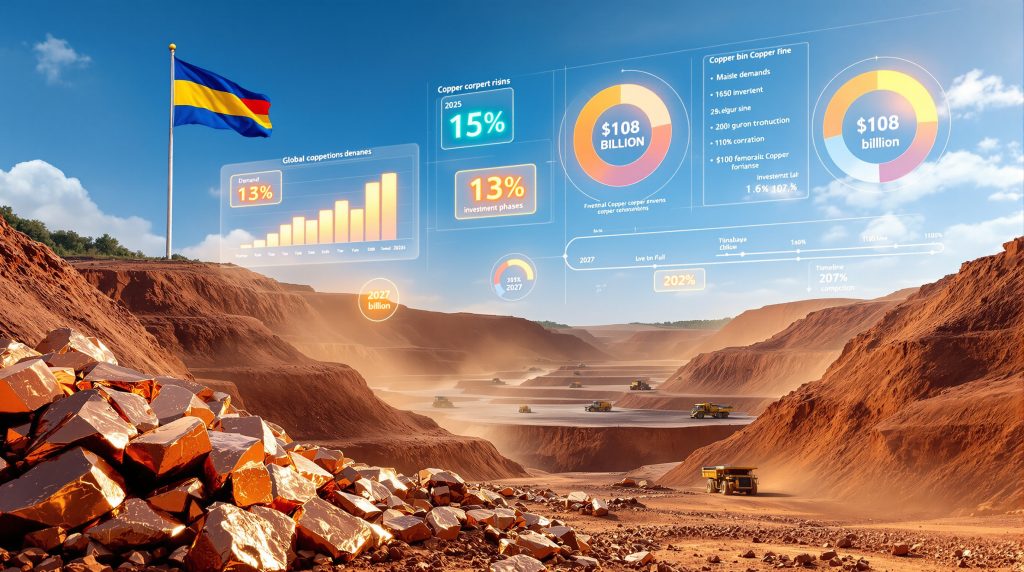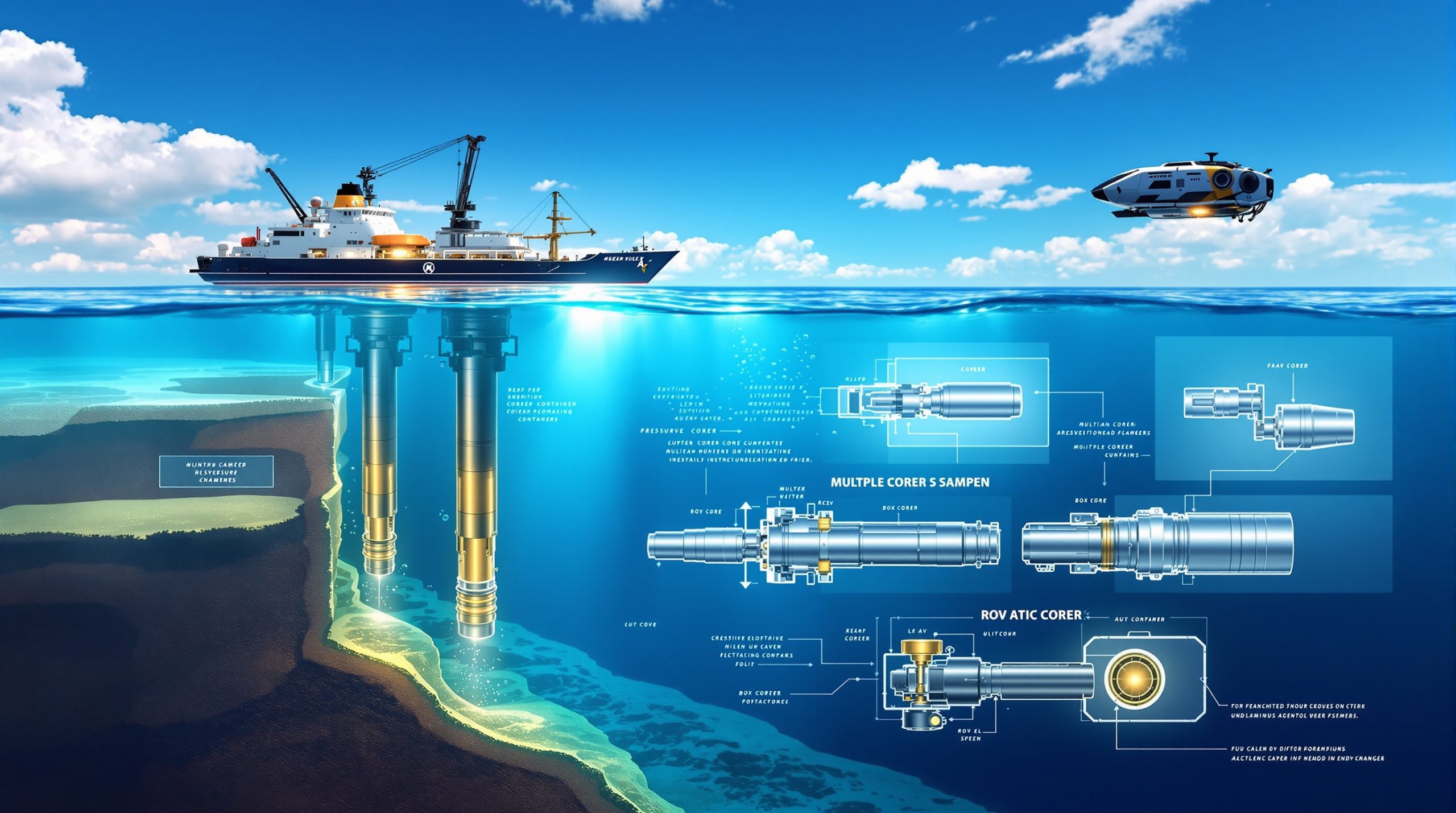CMOC's strategic decision to expand Kisanfu copper mine with a $1.08 billion investment reflects careful market positioning during a critical supply-demand imbalance period. This Chinese expansion strategy demonstrates sophisticated capital allocation as global copper markets face unprecedented shortages. Board approval for the $1.08 billion investment was announced on October 24, 2025, targeting an additional 100,000 tonnes of annual copper production capacity by 2027.
Global Copper Supply Deficit Creates Expansion Opportunity
Current global copper production faces unprecedented challenges as existing mining operations struggle to meet accelerating demand from multiple sectors. The Democratic Republic of Congo exported 3.1 million tonnes of copper in 2024, representing a 13% year-over-year increase, establishing its position as the world's second-largest copper producer after Chile.
The International Energy Agency projects a potentially catastrophic copper supply deficit reaching 40% by 2035, driven primarily by energy transition requirements and artificial intelligence infrastructure development. Furthermore, this global copper supply forecast creates substantial market opportunities for producers capable of expanding capacity efficiently.
| Year | Projected Demand (Million Tonnes) | Current Supply Capacity | Deficit Gap |
|---|---|---|---|
| 2025 | 25.8 | 25.2 | 2.3% |
| 2030 | 32.4 | 28.1 | 13.3% |
| 2035 | 41.2 | 29.7 | 27.9% |
DRC's Position as Africa's Copper Production Hub
The Central African copper belt possesses unique geological characteristics that support large-scale extraction operations with relatively predictable ore grades and processing requirements. This geological advantage, combined with established mining infrastructure, enables cost-effective capacity expansions compared to greenfield development projects.
China's role as the primary importer of DRC copper production creates direct market pull for increased output from Congolese mining operations. This relationship ensures immediate demand absorption for expanded production capacity, reducing market risk typically associated with major mining investments.
The strategic importance of Central African copper resources extends beyond immediate supply considerations. As global mining companies seek to diversify supply chains away from politically sensitive regions, the DRC offers relative stability within established operational frameworks supported by Chinese capital investment.
What Makes the Kisanfu Mine Expansion Economically Viable?
Current Production Baseline and Expansion Targets
Kisanfu currently delivers more than 150,000 tonnes of copper concentrate annually through established processing infrastructure. The planned expansion will increase this capacity by 100,000 tonnes annually post-2027, representing a 67% production increase from current levels.
The expansion represents approximately $10,800 per tonne of additional annual capacity, indicating competitive capital intensity compared to industry benchmarks for similar projects globally.
This capital efficiency stems from leveraging existing infrastructure investments rather than constructing entirely new processing facilities. The approach demonstrates sophisticated capital allocation strategies that maximize return on invested capital while minimising development risk.
Infrastructure Synergies with Existing Operations
CMOC to expand Kisanfu copper mine benefits from shared processing facilities with the nearby Tenke Fungurume Mine, enabling cost optimisation through integrated logistics networks. This infrastructure sharing reduces duplicate capital expenditure requirements and operational costs compared to standalone mining developments.
Existing transportation corridors, power supply infrastructure, and processing equipment provide foundation capacity that can accommodate increased throughput with incremental rather than transformational capital investment. This operational leverage creates significant economic advantages over greenfield alternatives.
The integrated approach allows CMOC to distribute capital across existing infrastructure while optimising processing efficiency through technological improvements and equipment upgrades rather than complete facility replacement.
Cobalt Co-Production Revenue Streams
Byproduct cobalt extraction during copper processing operations provides additional revenue streams that improve overall project economics. The Democratic Republic of Congo dominates global cobalt supply with greater than 80% market share, positioning CMOC within critical supply chains for electric vehicle battery production.
Additionally, cobalt production trends have demonstrated significant volatility but maintain structural demand support from battery manufacturing growth. This co-production capability provides revenue diversification and risk mitigation against copper price fluctuations during the project's operational lifespan.
The strategic positioning within both copper and cobalt supply chains enhances the project's resilience to single-commodity market volatility while capturing value from multiple end-use applications driving the global energy transition.
How Does This Expansion Compare to Other Major African Copper Projects?
Chinese Investment Patterns in DRC Mining Sector
The Kisanfu expansion forms part of a coordinated Chinese strategy encompassing multiple concurrent copper projects across the Democratic Republic of Congo. Kamoa-Kakula's "Project 95" optimisation initiative targets 30,000 additional tonnes annually through concentrator improvements rather than mining expansion.
Zijin Mining controls 39.6% stake in Kamoa-Kakula, which delivered 437,061 tonnes in 2024 and targets 600,000 tonnes total annual production. This represents 37% production growth through operational optimisation and equipment upgrades rather than new mine development.
JinChuan Group's Musonoi project represents a complementary approach with 38,000 tonnes annual capacity expected by Q2 2026. This greenfield development demonstrates Chinese capital allocation across both existing asset optimisation and new mine development strategies.
Competitive Positioning Against Global Producers
The collective Chinese-backed expansions in the DRC represent approximately 168,000 tonnes of new annual copper capacity through three primary projects. This combined capacity addition equals roughly 5.4% of current DRC copper production, indicating substantial market impact potential.
| Project | Company | Additional Capacity (tonnes) | Investment (USD) | Timeline |
|---|---|---|---|---|
| Kisanfu Expansion | CMOC | 100,000 | $1.08 billion | 2027 |
| Kamoa-Kakula Project 95 | Zijin Mining (39.6%) | 30,000 | Not disclosed | Ongoing |
| Musonoi | JinChuan Group | 38,000 | Not disclosed | Q2 2026 |
The staggered commissioning timeline suggests coordinated market supply management among Chinese-affiliated operators to avoid simultaneous production surges that could depress copper prices. However, recent copper price predictions indicate strong underlying demand support.
Chinese capital concentration across multiple DRC copper assets indicates deliberate portfolio management to secure long-term supply security rather than opportunistic investment. This coordinated approach contrasts with traditional competitive dynamics in global mining markets.
What Are the Financial and Operational Risk Factors?
Geopolitical Considerations in DRC Operations
Political stability assessment represents a critical component of the $1.08 billion investment decision, particularly given the scale and duration of capital commitment required. The DRC government controls equity stakes in competing projects through state-owned Gécamines, including 20% of Kamoa-Kakula and 25% of Musonoi.
Government revenue-sharing mechanisms create complex stakeholder dynamics where copper price volatility directly affects state revenues. This relationship could generate political pressure to renegotiate contract terms or accelerate production schedules regardless of operational constraints during commodity price cycles.
Mining code compliance and permit renewal processes require ongoing government relationship management and regulatory adherence. Historical precedent indicates periodic policy adjustments that can affect operational autonomy and financial returns for foreign operators.
Capital Allocation and Return Expectations
The investment represents CMOC's largest single expansion commitment in the DRC, requiring careful financial structuring to manage construction risk and operational ramp-up challenges. Capital intensity of $10,800 per tonne indicates competitive positioning relative to global copper project benchmarks.
Financing structure considerations include currency exposure management, given revenue generation in USD while potential cost components may be denominated in local currency or alternative currencies. This creates exchange rate risk that requires hedging strategies or natural currency matching through cost structure optimisation.
Return calculations depend critically on copper price assumptions throughout the project's operational lifespan. Extended payback periods typical of large mining investments create sensitivity to commodity price volatility and operational performance versus projections.
Environmental and Social Governance Requirements
International mining operations must demonstrate compliance with established ESG standards, including environmental impact mitigation strategies and community engagement protocols. Local employment generation targets create additional operational requirements and cost considerations.
Community impact assessments and stakeholder management represent ongoing operational requirements that affect both project development timelines and long-term operational costs. These requirements necessitate dedicated management resources and community investment programs.
Environmental monitoring and remediation protocols create long-term liability considerations that extend beyond operational completion. These obligations require financial provisioning and operational planning throughout the mine's productive lifespan.
When Will the Kisanfu Expansion Impact Global Copper Markets?
Construction Timeline and Production Ramp-Up
CMOC projects a two-year development schedule with commissioning expected in 2027, followed by phased production increases through 2028-2029 to achieve full capacity. This timeline reflects integration complexity with existing processing infrastructure rather than typical greenfield development constraints.
The 100,000 tonnes additional capacity represents 3.2% increase over current DRC copper output, creating measurable but not transformational impact on global supply availability. Market absorption depends on concurrent demand growth from energy transition and infrastructure development.
Production ramp-up trajectory will determine actual market impact timing, as gradual capacity increases over multiple quarters create different supply dynamics than immediate full production achievement. Integration with existing Tenke Fungurume processing facilities may impose constraints on ramp-up speed.
Market Supply Chain Integration
China's position as the primary importer of DRC copper production ensures direct market channel for increased Kisanfu output. Established logistics infrastructure including rail transportation to ports and shipping capacity provides foundation for market integration.
Key production milestones include:
• Q4 2025: Construction commencement and equipment procurement
• Q2 2026: Infrastructure development and processing equipment installation
• Q4 2026: Commissioning preparation and workforce training completion
• Q1 2027: Initial production startup and testing phases
• Q4 2027: Target production ramp-up to 50% capacity
• Q2 2028: Achievement of full 100,000 tonnes additional annual capacity
Export logistics coordination with other DRC producers becomes critical as collective Chinese-backed expansions increase total shipping requirements through existing transportation corridors. Infrastructure capacity constraints may require coordinated shipping schedules or additional logistics investment.
Which Other Mining Companies Are Expanding in the Region?
Comparative Analysis of Concurrent Copper Projects
The regional copper expansion landscape reflects concentrated Chinese capital deployment across multiple complementary strategies. Kamoa-Kakula's recovery rate optimisation through concentrator improvements represents lower-risk capacity addition compared to greenfield development approaches.
Zijin Mining's 39.6% stake in Kamoa-Kakula provides operational control and strategic decision-making authority over production optimisation initiatives. Mining.com reports that the Project 95 concentrator upgrade demonstrates how existing infrastructure can unlock additional capacity through technological enhancement.
JinChuan Group's approach through the Musonoi project represents full greenfield development with 38,000 tonnes annual capacity. This diversified strategy indicates Chinese operators pursue both existing asset optimisation and new mine development simultaneously rather than exclusive focus on either approach.
Strategic Implications for Global Copper Supply
| Company | Project Type | Capacity Addition | Risk Profile | Capital Intensity |
|---|---|---|---|---|
| CMOC | Existing Asset Expansion | 100,000 tonnes | Medium | $10,800/tonne |
| Zijin Mining | Concentrator Optimisation | 30,000 tonnes | Low | Undisclosed |
| JinChuan Group | Greenfield Development | 38,000 tonnes | High | Undisclosed |
The collective 168,000 tonnes of new annual capacity from Chinese-backed projects represents strategic positioning to capture market share during anticipated supply deficits through 2035. This coordinated expansion suggests long-term supply security objectives rather than short-term profit maximisation.
Market concentration risks emerge as Chinese entities control increasing proportions of DRC copper production through multiple projects and ownership structures. Reuters analysis suggests this concentration creates potential supply chain vulnerabilities for copper-dependent industries seeking geographic diversification.
The sustainability of current expansion pace depends on continued Chinese capital availability and stable regulatory environment in the DRC. Policy changes or investment strategy shifts could affect completion of announced projects and long-term supply projections.
Frequently Asked Questions About CMOC's Kisanfu Expansion
What is CMOC's ownership structure in the Kisanfu mine?
CMOC operates the Kisanfu mine through direct ownership and management control, though specific equity percentages and joint venture partner details were not disclosed in the expansion announcement. The government of the Democratic Republic of Congo typically maintains revenue-sharing mechanisms and royalty structures rather than direct equity participation in CMOC-operated assets.
Government stake arrangements through Gécamines vary across different mining projects in the DRC, with 20% participation in Kamoa-Kakula and 25% in Musonoi representing comparable structures. These arrangements ensure state revenue participation while allowing private operators to maintain operational control and decision-making authority.
How does this expansion affect copper price forecasts?
The 100,000 tonnes additional annual capacity represents incremental supply that could moderate price increases during periods of supply constraint but unlikely to create surplus conditions given projected demand growth. Energy transition requirements and artificial intelligence infrastructure development continue driving structural demand increases.
Medium-term pricing projections must account for concurrent capacity additions from Kamoa-Kakula and Musonoi projects, creating combined 168,000 tonnes of new annual supply from Chinese-backed DRC operations. This collective impact may create more significant price moderation than individual project effects.
Supply increase timing relative to demand growth trajectories will determine actual price impacts. If energy transition acceleration occurs faster than anticipated, additional supply may be absorbed without significant price pressure through 2027-2030.
What are the environmental safeguards for the expansion project?
International mining operations require compliance with established environmental monitoring protocols and impact mitigation measures, though specific details for the Kisanfu expansion were not disclosed. Community impact assessments and stakeholder engagement programs represent standard requirements for major mining developments.
Environmental safeguards typically include:
• Water quality monitoring and treatment systems
• Air quality management and dust control measures
• Soil contamination prevention and remediation protocols
• Wildlife habitat protection and biodiversity conservation
• Waste management and tailings facility safety standards
• Community health and safety protection measures
Regulatory compliance requirements in the DRC include both national mining code adherence and international best practice standards expected by Chinese operators and potential financing institutions supporting the project development.
Conclusion: Strategic Positioning for Future Copper Demand
Long-term Market Outlook and Investment Rationale
CMOC to expand Kisanfu copper mine represents strategic positioning to capture value from anticipated supply-demand imbalances through 2035 and beyond. The $1.08 billion investment reflects confidence in structural demand growth driven by energy transition requirements and technological infrastructure development.
The International Energy Agency's projection of 40% supply deficit by 2035 creates substantial market opportunities for producers capable of expanding capacity efficiently through existing asset optimisation. CMOC's integrated approach leveraging shared infrastructure with Tenke Fungurume operations demonstrates sophisticated capital allocation strategies.
Energy transition acceleration, artificial intelligence infrastructure growth, and global electrification trends create sustained copper demand increases that exceed current mining project development pipeline capacity, establishing favourable long-term market conditions for strategic capacity expansion investments.
Implications for Global Mining Industry
The trend toward existing asset optimisation versus greenfield development reflects rational capital allocation during periods of extended development timelines and increased regulatory complexity. CMOC's expansion approach through infrastructure sharing and processing capacity enhancement offers superior risk-adjusted returns compared to standalone mining development.
Chinese capital concentration in the DRC copper sector demonstrates coordinated strategic positioning rather than competitive market dynamics. The staggered commissioning timeline across multiple projects suggests sophisticated supply management to optimise market conditions and price stability.
Supply chain security considerations for copper-dependent industries highlight the importance of geographic and operational diversification. The increasing Chinese control over DRC copper production creates potential concentration risks that may influence global supply chain strategy development for major industrial consumers.
Consequently, the mining industry evolution demonstrates how existing asset expansion strategies like CMOC to expand Kisanfu copper mine may influence broader industry approaches toward capacity addition, favouring optimisation and integration over traditional greenfield exploration and development models.
Interested in Capitalising on Copper Market Opportunities?
Discovery Alert's proprietary Discovery IQ model delivers real-time alerts on significant copper and mineral discoveries across the ASX, instantly empowering subscribers to identify actionable opportunities ahead of the broader market. Begin your 30-day free trial at Discovery Alert today and secure your market-leading advantage in this rapidly evolving sector.




